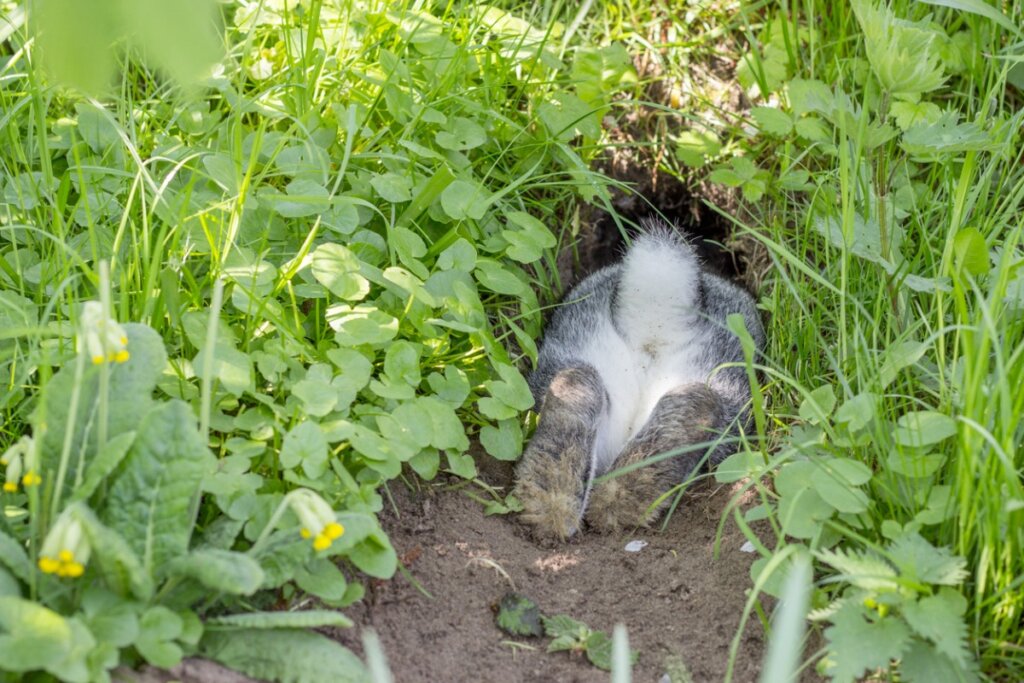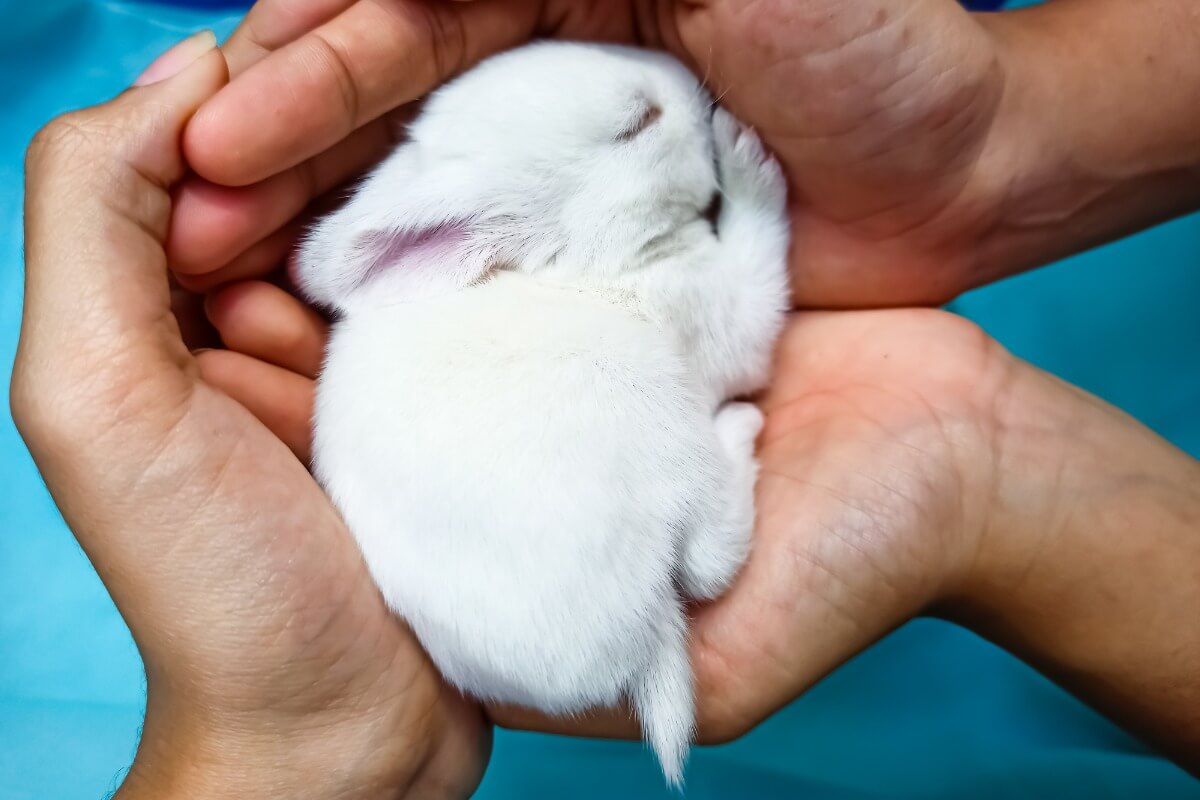15 Interesting Facts About Rabbit Tails

Anyone who lives with a rabbit or in a country where they can observe this species in the wild will be used to their behavior in some way. However, if we analyze them carefully, we’ll find that they’re rather strange animals – with their long ears, paws without pads, and a furry tail. They aren’t rodents or ruminants, but their digestive system is very similar to the horse’s! And, in today’s article, we’ll be looking at the fascinating world of rabbit tails.
If you think that there’s not much to discuss about this topic, then think again – you’ll be amazed! Don’t miss it.
Relevant information about rabbit tails
It’s sometimes difficult to find a rabbit’s tail, as genetic selection has endowed them with a morphology that’s more adorable than practical as far as we can see. The area of the tail is surrounded by soft, fluffy far and the tail remains somewhat hidden. However, all lagomorphs have one and you explore that area.
1. Rabbit tails aren’t pompom-shaped
Although we tend to think this is the case, the truth is that rabbit tails, if you see them stretched out, are more like a deer’s tail than a pompom. When they’re standing, however, the fur on the back hides the tail and gives the impression that it’s more rounded.
2. When they’re relaxed, they stretch their tails
Rabbits are prey animals that rarely relax unless they’re confident that their environment is safe. So if you have built a positive relationship with your lagomorph, you may see them lie on their side and stretch their tail. This is when this part of his body is best observed.
3. The world’s longest tail measures 17 centimeters
The record for the longest rabbit tail belongs to Darius, a lagomorph who lives in England with its breeder. Its tail is 17 centimeters (nearly 6 inches) long, 12 centimeters (5 inches) longer than the average for other rabbits.
4. Not all rabbits have white tails
Wild rabbits have white under tails, regardless of the color of their coat (which is normally brownish). In domestic specimens, however, this isn’t always the case. Some have tails that are the same color as their coat, or even a different one, as a result of artificial genetic selection.
5. The rabbit’s tail has bone, muscle, and nerves
Although they look like an extension of fur, the truth is that if you examine the area you’ll find a small extremity of flesh and bone, which is pointed. In fact, it’s a delicate part of the animal’s anatomy, so be careful not to step on it or injure it in general, as it’ll cause it a lot of pain.
6. An injury to the tail can affect other parts of the body
As mentioned in the previous section, rabbits’ tails are innervated, so an injury in this area could also affect other parts of their anatomy. Severe damage near the base is capable of injuring the nerves that control the fecal and urinary sphincters, causing incontinence and many other physiological problems.
7. A rabbit’s tail is always closely attached to the body
This fact may seem trivial to you, but the truth is that everything has a reason in nature. Animals that have to flee from predators in order to stay alive usually have short tails that are very closely attached to the body. This ensures that their hunter won’t be able to grab hold of their tail when chasing them from behind.
8. The white color of the tail also serves a purpose
Since the coloration of a wild rabbit’s coat is useful for camouflage in the environment, it’s difficult to know why the lower part of its tail is a bright shade of white. However, this also helps lagomorphs to survive. When running in a zigzag pattern, the constantly moving white spot seen by predators confuses them and often causes them to stop their pursuit of the rabbit.
9. It helps their balance
Surely you have seen how your rabbit goes up on its hind legs to smell or look at something above its head. You’ll have also observed that, at that moment, they stretch their tail towards the ground. In this way, it helps to keep their balance.
If you’re curious about this, try videoing it as it runs and makes sharp turns. Play it back in slow motion and you’ll see how their tail helps it to move this way.
10. It’s also a form of communication
When the rabbit finds itself in a tense situation, it raises its tail so that the white color is more visible. This is a way of warning their closest companions that they have detected danger. When they adopt this pose, they’re likely to flee, but they’re also likely to attack.
11. Rabbits wag their tails
Although we always think of dogs when we talk about tail wagging, the truth is that rabbits also wag their tails. However, with rabbits, the reasons are different; they give a brief, side-to-side shake to show that something is irritating them. This shows that they’re likely to attack if what’s bothering them doesn’t go away.
12. Never pull your rabbit’s tail
We surely don’t need reminding of this, but it doesn’t hurt to mention it. As mentioned above, a rabbit’s tail has bone and muscle, and they’re innervated and irrigated. Therefore, pulling on them causes pain and could injure them.
Rabbits hate to be touched on their backs without warning.
13. Beware of obesity
Apart from all the problems that obesity implies in any animal, there’s another factor in the case of rabbits. If they’re too fat, they won’t be able to reach their tails to groom them. This usually results in the accumulation of feces and urine in this area, increasing the probability of infection or other ailments.
14. Any cut on a rabbit’s tail will bleed profusely
Several blood vessels accumulate in a rabbit’s tail, and so a small cut will cause a lot of bleeding. If you ever find yourself in this situation, keep calm. Press the wound with gauze or a clean cloth and go to the veterinarian.
15. A rabbit’s tail can become hairless
A loss of hair or alopecia is a sign that something is wrong with the rabbit’s health. It could be parasites, dermatitis, wounds, kidney problems and many other ailments which should be diagnosed by a veterinarian. Sometimes alopecia affects the tail, suggesting skin or urinary problems. If you observe this in your lagomorph, go to the clinic without delay.

As you can see, we can discuss the topic of rabbit tails at length. If you live with one of these cute animals, you’ll have learned something new about their behavior and characteristics. They’re such lovely animals, and yet there’s so much we don’t know about them!
All cited sources were thoroughly reviewed by our team to ensure their quality, reliability, currency, and validity. The bibliography of this article was considered reliable and of academic or scientific accuracy.
- Cressey, D. (2013, 7 agosto). Why rabbits have white tails : News blog. Science News. Recuperado 26 de enero de 2022, de http://blogs.nature.com/news/2013/08/why-rabbits-have-white-tails.html
- The Open Sanctuary Project, Inc. (2021d, septiembre 1). Daily Diet, Treats And Supplements For Rabbits. The Open Sanctuary Project. Recuperado 26 de enero de 2022, de https://opensanctuary.org/article/daily-diet-treats-and-supplements-for-rabbits/